Beyond the Call (40 page)
Authors: Lee Trimble

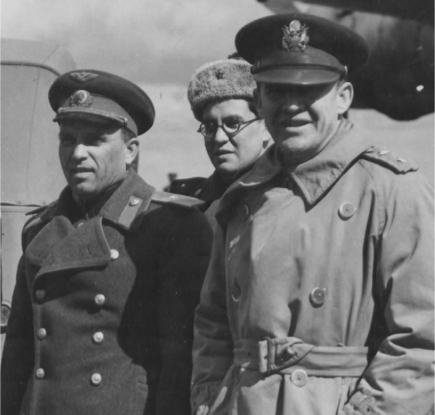
27. Major General S.K. Kovalev and Major General John R. Deane at Poltava, 12 April 1945.
(US Air Force)
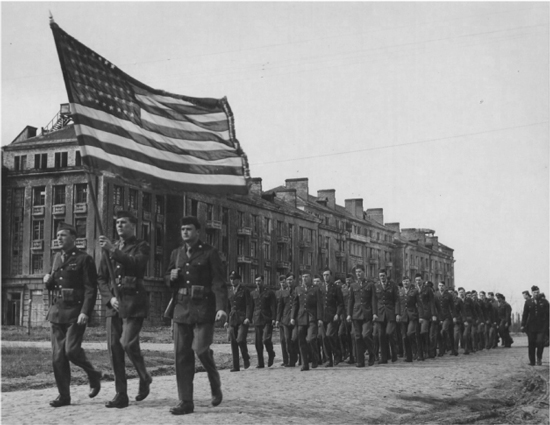
28. Color guard leading the march through the American camp to the memorial service for President Roosevelt.
(US Air Force)
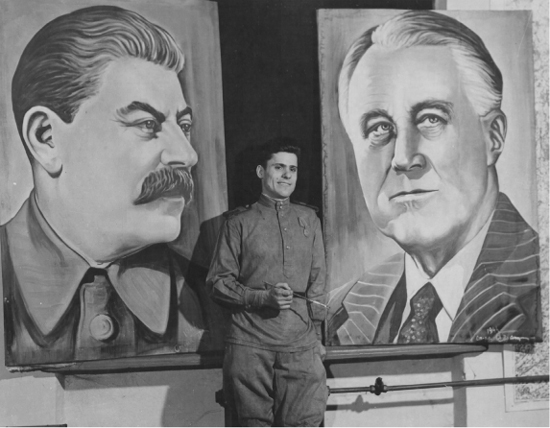
29. Soviet artist Senior Sergeant Sapokar with his portraits of Stalin and Roosevelt.
(US Air Force)
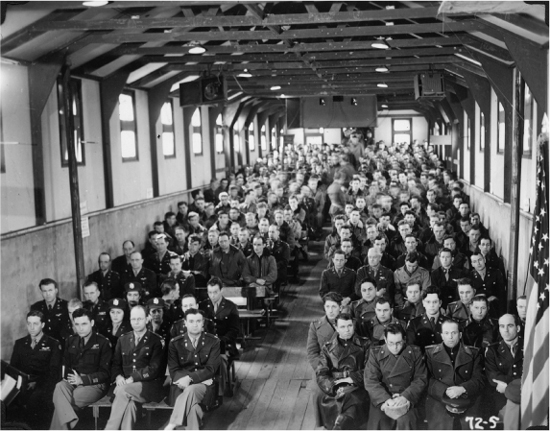
30. Memorial service for Franklin D. Roosevelt, held in the theater at Poltava on 14 April 1945. Newly appointed commanding officer Captain Trimble is seated front left. Front far right is outgoing commanding officer Colonel Thomas K. Hampton.
(Kaluta family)
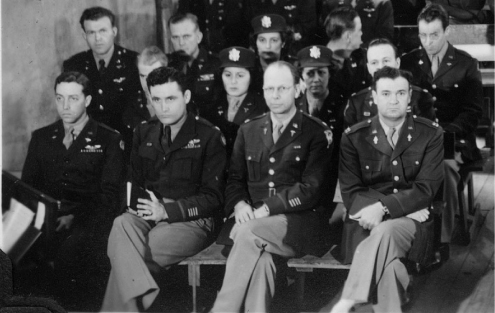
31. Memorial service congregation (detail). Captain Robert M. Trimble seated front left, with Major Michael H. Kowal beside him. Behind Captain Trimble is Captain William Fitchen.
(Kaluta family)
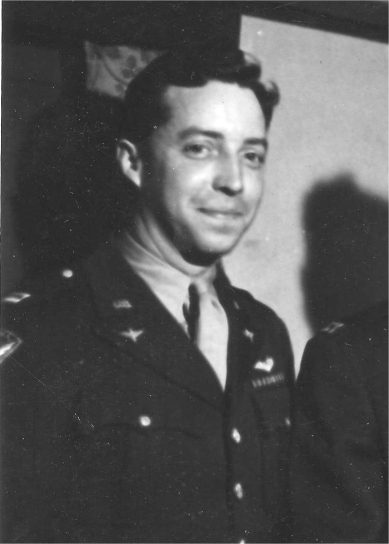
32. Captain Robert M. Trimble at Poltava, April 1945.
(Kaluta family)
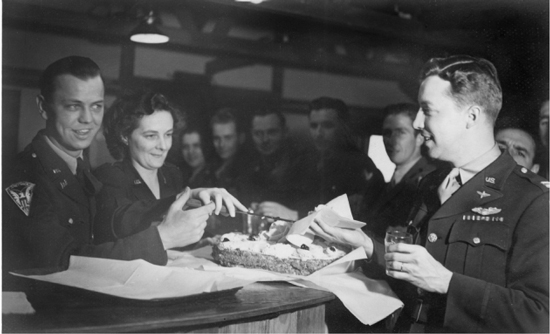
33. Lt William Kaluta and Lt Clotilde Kaluta serving wedding cake to Captain Robert M. Trimble in the Officers' Club at Poltava, 20 May 1945. Kaluta's shoulder patch is that of the Military Mission to Moscow, a US eagle with the logo âÐÐÐÐ ÐÐÐ' â âAmerica' in Cyrillic letters.
(Kaluta family)
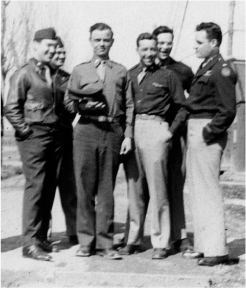
34. Eastern Command officers at Poltava.
From left: Maj. Don Nicholson, Lt Bill Kaluta, Capt. Robert Trimble, (unknown), Maj. Mike Kowal.
(Kaluta family)
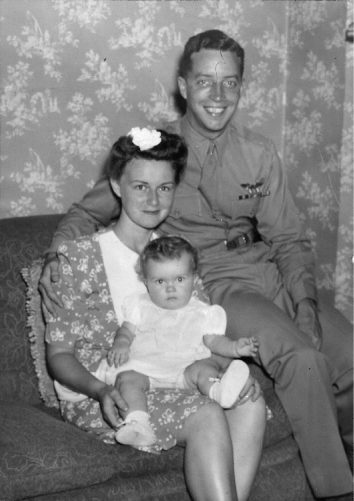
35. Robert and Eleanor Trimble with baby Carol Ann, shortly after Robert's return to the US, summer 1945.
(Lee Trimble)
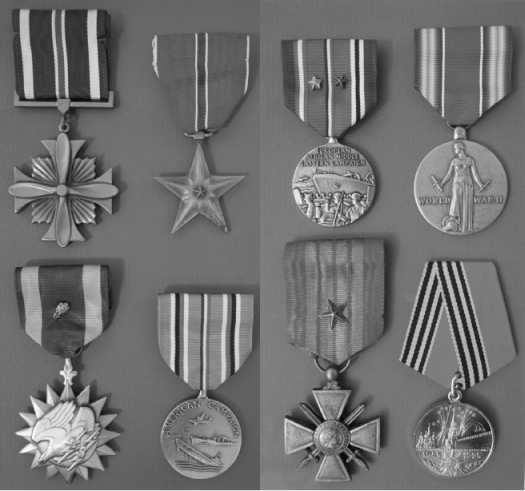
36. Medals awarded to Robert M. Trimble: (top row, left to right) Distinguished Flying Cross, Bronze Star, European African Middle Eastern Campaign Medal, World War II Victory Medal; (bottom row, left to right) Air Medal, American Campaign Medal, Croix de Guerre with Silver Star, Fiftieth Anniversary Great Patriotic War Commemorative Medal.
(Lee Trimble)
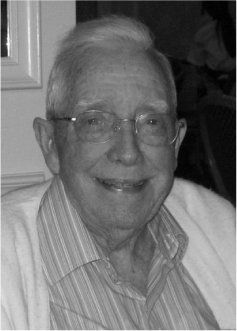
37. Robert Trimble in 2009.
(Lee Trimble)
ENDNOTES

Prologue
1
.   By the end of 1944, more than 5 million forced foreign laborers, male and female, were working in German agriculture and industry, of whom about 1.3 million were French (see Herbert,
Hitler's Foreign Workers
, as well as Beyer and Schneider, âForced Labor', for summaries).
2
.   The Soviet military and security police sometimes put abandoned Nazi prison camps to their own uses. For instance, the Janowska concentration camp in Lwów was taken over by the NKVD and used as a prison camp (Bartov, âWhite Spaces and Black Holes', p. 324). Likewise, the Majdanek death camp was briefly used to hold liberated British and American POWs (Wilmeth, âReport', pp. 2â3).
Chapter 1: One Lucky Bastard
1
.   Five members of the combat crew bailed out over the North Sea, while the remaining flight crew went on to make a forced landing at RAF Woodbridge, some five miles short of Debach (Freeman et al.,
Mighty Eighth
, p. 410). Wood-bridge, being near the coast, received thousands of emergency landings during the course of the war.
2
.   The 493rd did indeed move to the former fighter station at Little Walden in March 1945, while repairs were effected. They returned to Debach in April 1945 and flew their last combat mission on 20 April. In August 1945 the 493rd returned to the United States (Bowyer,
Action Stations
, p. 92; Bowman and Woodall,
Helton's Hellcats
, p. 9).
3
.   This crew was fairly unusual in that all but three of them stayed together and completed their tour simultaneously (USAAF 863rd Bombardment Squadron, Record of Sorties). Crews were often split up, and their members finished their tours individually (or not at all, in many cases).
4
.   Mission #76 to Merseberg on 30 October 1944 was recalled when already over Germany, due to low cirrus cloud over the target and very heavy contrails
from the bombers, obscuring one another's view (USAAF 493rd Bombardment Group mission reports). As they had experienced some light flak en route, the crews were credited with a combat mission (see Weir, âNavigating Through World War II').
5
.   USAAF interrogation report, Mission #100.
6
.   Elbert Helton was born in Clifton, Texas, in 1915, and joined the Army Air Corps (as it was then called) in 1936. By the time he took command of the newly created 493rd Bombardment Group in November 1943, at the age of 28, he was already a veteran squadron commander and combat pilot (Bowman and Woodall,
Helton's Hellcats
, p. 26).
7
.   Casualties from the mission of 30 December 1944, (mission #100 for the 493rd BG) were relatively light. Altogether the 3rd Air Division, of which the 493rd Bomb Group was a part, dispatched 526 bombers to various targets. Three aircraft were lost, 37 damaged, and 24 men were MIA (Freeman et al.,
The Mighty Eighth
, p. 409).
8
.   The notorious Magdeburg mission took place on 12 September 1944. Due to slack formation flying, the bombers were insufficiently protected by the arcs of fire from their guns. The 493rd was attacked front and rear by Fw 190s from JG 53 and JG 300. Seven bombers were shot down and many more were damaged, two so badly that they had to make forced landings in Belgium. According to the official mission report, of the B-17s shot down, four âwent down in flames and exploded'. Of the seven planes lost over the target, just âfive or six chutes were seen' (Freeman et al.,
The Mighty Eighth
, p. 345; Caldwell and Muller,
Luftwaffe over Germany
, p. 235; USAAF interrogation report, Mission #55).
9
.   At this time, Eighth Air Force bomb groups each comprised four squadrons of twelve aircraft each (for a total of 48; in 1945 squadron size increased to eighteen, for a total of 72). Normal mission procedure was for three squadrons to fly while the fourth stood down. Squadrons took turns to stand down.
10
. Including dead, wounded, and missing, the Eighth Air Force lost 34 per cent of its aircrew personnel in combat, âthe highest casualty rate in the American armed forces in World War II'; Eighth Air Force aircrew accounted for about one-tenth of all America's war dead (Miller,
Eighth Air Force
, p. 471).
11
. On the mission of 31 December 1944, the 3rd Air Division again dispatched 526 bombers to various targets, including Misburg. Twenty-seven bombers were lost and 288 were damaged; five men were killed, 29 wounded, and 248 missing (Freeman et al.,
The Mighty Eighth
, pp. 410â11). The 493rd Bomb Group lost one aircraft from the 862nd Squadron (Bowman and Woodall,
Helton's Hellcats
, p. 14).
12
. Thirteen days later, on 13 January 1945, B-17 43-38271,
Big Buster
, in which Robert Trimble had flown his last mission, was shot down by flak near Bauschheim during a mission to Mainz, Germany. It was being piloted by Lieutenant Norman S. Lamoreaux, who had flown alongside Captain Trimble on the Kassel mission on 30 December. Six of the crew were killed and three taken prisoner (Bowman and Woodall,
Helton's Hellcats
, p. 21; Freeman,
The B-17 Flying Fortress Story
, p. 244).
Chapter 2: An American in London
1
.   Grosvenor Square still has a strong American presence, with statues of Roosevelt and Eisenhower in the central garden, along with a memorial to 9/11. The building at the south-east corner of the square which in 1945 was the US Embassy now houses the Canadian High Commission. The US Embassy moved to new premises at the other end of the square in 1960. In 2017 the embassy will move again, to a new site on the far side of central London. Once it goes, all that will be left of âLittle America' will be the statues.
2
.   As described by Dorothy Brannan, former WAAF barrage balloon operator, in BBC WW2 People's War archive, available online at
www.bbc.co.uk/history/ww2peopleswar/stories/83/a4551383.shtml
(retrieved 23 February 2014).
3
.   âWhitewash' was the call sign of the 493rd Bomb Group control tower, âPillar' was the call sign of the 863rd Bomb Squadron, and 366 was the individual ID number of the aircraft Captain Trimble's crew was flying that day (Bowman and Woodall,
Helton's Hellcats
, p. 9; USAAF 493rd Bombardment Group mission reports).
4
.   OSS/London,
War Diaries
, vol. 7, Apr.âJun. 1944, p. 3; vol. 8, passim.
5
.   Ibid.
6
.   Bowman,
Bedford Triangle
, pp. 60â4.
7
.   For example: â5. Do not ask Joes personal questions. (For example: Questions concerning name, job or background.) ⦠15. Neither you, nor any member of your crew, will give the Joes any information concerning past, present, or future operations. This includes flight plan, routes, and altitudes, etc., of the operation tonight.' From âHints for Dispatchers' in OSS/London,
War Diaries
, vol. 6, Jan.âMar. 1944, pp. 43â4.
8
.   Bowman,
Bedford Triangle
, p. 45.
9
.   Persico,
Piercing the Reich
, pp. 41â2; 169â70.
Chapter 3: The Long Way Round
1
.   Originally a B-17 crew numbered ten men. By this stage in the war, the threat from enemy fighters had reduced, and the crew complement had been reduced
to nine by the deletion of one of the waist gunners (a single gunner was thus responsible for both guns).
2
.   US Consular Service passport issued to Captain Robert M. Trimble, 22 January 1945.
3
.   Most military aircraft of this period did not have the range to make the crossing from the United States to the UK in one leg.
4
.   The stop at Fortaleza and the journey to Africa were described in a short memoir written by the crew's radio operator, Sergeant Gale D. Moore (Moore, âCalifornia to Combat').
5
.   Sulfonamide (or âsulfa') is an antimicrobial drug that was the standard treatment for infection at this time. Antimicrobials preceded antibiotics and work differently.
6
.   The North American B-25 Mitchell, despite having only two Wright Cyclone engines (the same type used in the B-17), was notoriously loud due to the design of the engine cowlings and exhaust system (Higham and Siddall,
Flying Combat Aircraft
, p. 8).
7
.   âWay the hell out over northern New Mexico someplace [Trimble] let his hair down a little. ⦠We dropped down so we were just buzzing the coyotes and cacti and Johnson, the co-pilot played “I'll Walk Alone” on his trumpet over the command radio.' (Moore, âCalifornia to Combat'.)
8
.   Leavell,
The 8th Evac
, p. 50ff.
9
.   The description of the consulate here is based partly on the recollections of Tuskegee airman Virgil Richardson, who stayed there a couple of months after the Trimble crew (Vinson,
Flight
, pp. 65â6).
10
. It's unclear why the crew was sent here, as it was a training base for fighter pilots and a trans-shipment stop for troops and cargo going to the Pacific.
11
. Both songs were hits during World War II. The former was a hit twice in 1942 â for the Glenn Miller Orchestra and for the Andrews Sisters. âTill Then' was a hit in September 1944 (toward the end of Eleanor's pregnancy) for the Mills Brothers. Both songs are about the parting of young couples in wartime. Whereas âApple Tree' is humorous, âTill Then' is a much more moving song and was the one Eleanor remembered being particularly affected by.
12
. A
ghalyan
is the Persian equivalent of the Arab hookah pipe.
13
. Huge quantities of British aid and American Lend-Lease supplies were shipped into the USSR during the war. The Persian Corridor was one of the key routes, the others being the northern sea route into Murmansk and the AlaskaâSiberia route. See Weeks,
Russia's Life-Saver
, pp. 27, 112â16; Matloff,
US Army in WW2
, pp. 283â4.
14
. Mohammed Reza Shah was particularly deeply involved in American diplomacy in Iran (Afkhami,
Life and Times of the Shah
, pp. 161â6ff).
15
. Ibid, p. 311ff.
16
. The TehranâPoltava route was served by three Poltava-based Soviet-crewed C-46 Commandos, flying twice a week (Kaluta, vol. I, ch. II, pp. 12â13). The C-46 model was older, much less reliable, and less numerous than the C-47, which may be why the USAAF allowed the Russians to have them.
17
. Robert didn't recall who these were. Most likely they were officers returning from leave in Cairo, which was the regular leave destination for Poltava personnel.
18
. A reference to this incident is given in Kaluta, vol. I, ch. II, p. 14.
Chapter 4: Behind the Curtain
1
.   Lepawsky,
History of Eastern Command
, chapter IV, p. 90.
2
.   Ibid, p. 101ff.
3
.   Eastern Command report on investigation into 21/22 June raid, copy included with Lepawsky,
History of Eastern Command
.
4
.   Ibid; also Infield,
Poltava Affair
, pp. 147â51.
5
.   Brigadier General Alfred A. Kessler, CO Eastern Command, interviewed 5 July 1944, transcript included in Lepawsky,
History of Eastern Command
.
6
.   Kaluta, vol. I, ch. I, p. 2.
7
.   Infield,
Poltava Affair
, pp. 162â3. At Mirgorod, most of the planes had been removed, but massive quantities of fuel and munitions were destroyed.
8
.   Rees,
World War Two Behind Closed Doors
, p. 54.
9
.   Ibid, p. 182ff. The atrocities became known as the Katyn Massacre because of the original discovery, but the majority of the killings were done elsewhere.
10
. Deane,
Strange Alliance
, pp. 55â6.
11
. CIA, âMemoranda for the President,' pp. 66â7.
12
. Ibid, pp. 73â4.
13
. Deane,
Strange Alliance
, pp. 55â63.
14
. Hill, Cable M21977 to Hampton.
15
. Bowman,
Bedford Triangle
, p. 45.
16
. Ibid, pp. 40â6.
17
. If it is true that Hill was inserted as a deniable conduit for the OSS, it is extremely unlikely that it was done expressly for the purpose of POW exfiltration. More likely he was intended as a general OSS contact who could be used if and when required. The Soviets were deeply suspicious of him and at the end of the war tried to prevent his departure from the USSR (Infield,
Poltava Affair
, pp. 218â20).
18
. Captain Trimble's arrival at Poltava was either 14 February, based on the date given by Kaluta (vol. I, ch. II, p. 14) for the stopover at Armavir, or 15 February, the date recorded for Trimble's appointment as assistant operations officer (Hill, letter to Spaatz on promotion of officer, 16 May 1945). Since it is possible that the stopovers in Armavir and Rostov lasted more than one night each (due to the continuing bad weather), 15 February is accepted here as the correct arrival date.
